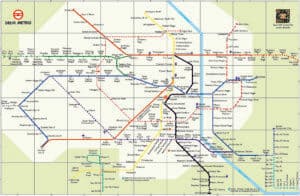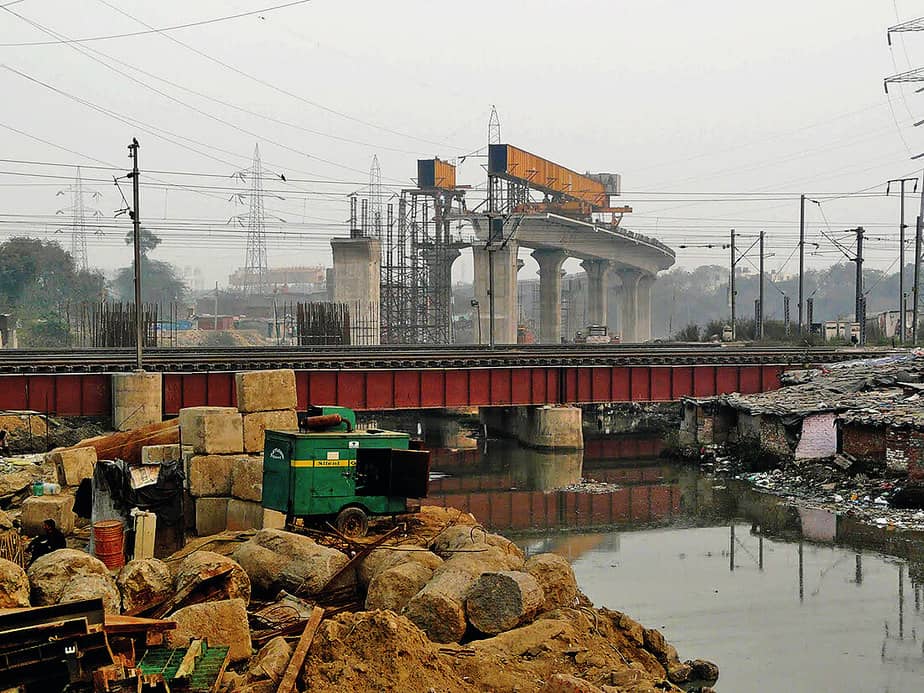Traffic bottlenecks continue to dog the city, despite all the scientific planning and the new Metro routes and flyovers. Perhaps the answer lies in project delays
Delhi is a city of constant construction. When will one be able to see roads without girders, scaffolding, and the haze of dust, coupled with the inevitable traffic congestion and diversions? Perhaps never. More flyovers will inevitably get sanctioned and new Metro tracks will be built.
Of course, these are all needed to make the city better connected and truly modern, but is there a method in the madness? Two stations in the soon-to-be-opened Magenta Metro line connecting Botanical Garden to Janakpuri have been accused of creating new bottlenecks instead of smoothing traffic.
The stations’ exit and entry points for commuters of Chirag Delhi and Greater Kailash are situated right on busy main roads. This would mean autorickshaws, cabs and private cars waiting near the exits, making traffic jams even worse. The Hauz Khas station’s exit on Ring Road always has a traffic mess, despite cops trying to keep the road clear.
Anuj Dayal, DMRC’s Executive Director, Corporate Communications, says that the corporation has constructed and maintained all the roads within its purview and they’ve carried out the construction as per the land given to them.
The segment of the Magenta line from Botanical Gardens to Kalkaji Mandir is already up and running. The opening of the second phase should ease travel for many passengers who take the Blueline (with an average of about 9 lakh riders per day) to connect to central Delhi (Rajiv Chowk), which then connects them to the South. A long way around, which sometimes means people choose to take the road instead, to save an hour.
Despite this ever-increasing infrastructure, Delhi’s roads are dogged by traffic congestion even on Sundays. Even at an ungodly hour, you will find yourself stuck in an ominous limbo, as people try to go home after a late night, surrounded by trucks carrying goods into the city or passing through it.
One prime example, and a situation common to many, is the Rao Tula Ram Marg flyover and even the area around RK Puram station.
Rao Tula Ram flyover, is synonymous with traffic and one that makes every person who has to pass through it quiver with unease. The construction of the 2.7-km parallel bridge next to the ill-designed one which somehow allows one car from each side to pass in a straight line, is slated to be completed in August 2018. Seeing the current state of affairs, there is all-round scepticism whether that will be achieved.

The construction of the flyover which began in November 2014 was supposed to continue till June 2018 on a budget of Rs 278 crore. Only 36% of the work had been completed till April this year, according to one report. Causes of delays have ranged from “funds constraint” and opposition by residents — and judging by the area, some wealthy, influential ones. The problems have caused the pocket of the Public Works Department (PWD) being further dented, with one report quoting an official as saying the cost of flyover had risen to Rs 330 crore.
The firm, Hindustan Construction Company (HCC) carrying out the construction has been warned of being blacklisted if it doesn’t meet its new deadline, while it has already been penalised for not sticking to its promises.
A spokesperson for the HCC told Patriot that, it did not want to dwell into the subject of being blacklisted. They did however point out that the project was “running behind schedule for reasons beyond the purview of the contractor, mainly due to delays in handing over of land, shifting of utilities and delay in tree cutting.”
They did want to strike an optimistic note, saying that the flyover work was “progressing well with 100% of piling, piers and pile caps” completed and “superstructure work being fast-tracked”.
Other than Rao Tula Ram Marg, another major road that has been facing constant delays is the Barapullah project. Divided into three stretches, Phase I connecting Sarai Kale Khan and Jawaharlal Nehru Stadium became operational for the 2010 Commonwealth Games that Delhi hosted. After that, it has seen a steady delay. Having missed three deadlines already, Phase II was initially slated to be finished in 2015 yet it even missed the March 2018 deadline. Reports say that now the road will be opened by June 2018, which will see the connection from Jawaharlal Nehru Stadium to INA market.
That still leaves Phase III, to be opened by 2020, connecting Mayur Vihar Phase I to Sarai Kale Khan.
For the last phase, 70% of the work should have been finished by the current year, but Deputy CM Manish Sisodia had pointed out in the Delhi Assembly in March that only 52% work had been completed by December 2017. And going by how slow work progresses, it’s anyone’s guess how much can be done by year-end.
There’s more soon to be in their baskets, with the Metro’s Phase IV project having been cleared by the Delhi government’s finance department for Janakpuri West to RK Ashram stretch, then Mukundpur to Maujpur and Lajpat Nagar to Saket G Block. In its allocation of funds, the Delhi government, led by Aam Admi Party had also earmarked Rs 1,281crore for roads and bridges.
While getting funds approved is one very important aspect, the government also needs to see its land acquition, so that delays don’t become more problematic than the ease that the state wants to offer.





